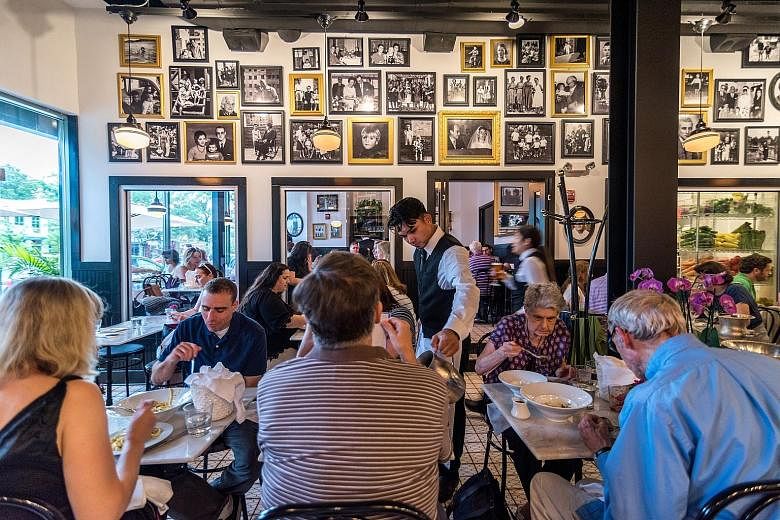WASHINGTON •A "packed restaurant" has taken on a new meaning.
To serve an example, take the case of Ms Meagan Foster and her then boyfriend, who were trying to turn a bad day around by venturing to the Tabard Inn in Washington for drinks and dinner.
But when she tried to navigate the sliver of space between her table and the next, she bumped into everything - votive, water, silverware - and promptly burst into tears.
The incident did not scar her for life - the duo later got married at the same eatery. But whenever they go back, they make sure to avoid the sardine-packed tables along one wall.
She is not the only diner tired of playing ballet dancer or contortionist for the privilege of a meal away from home.
To access some of the more tightly packed tables, anyone who is not slim has to enter seats sideways, sometimes on tiptoe, and invade a neighbour's space one of two ways: by butt or by crotch.
Like airlines, restaurants seem to be trimming personal space in an attempt to pack in more customers and this at a time when the average American man and woman are 13.6kg and 11.8kg heavier, respectively, than they were in 1960.
There is no industry standard for distance between tables, but Dr Stephani Robson, a senior lecturer at the School of Hotel Administration at Cornell University, considers 0.4m a good minimum.
But at the 14th Street branch of Busboys and Poets, the socially conscious eatery treats customers as if they were sardines, with just 0.3m separating some seats.
At the Tabard Inn, two tables were just 0.2m apart. This distance is about the length of a pencil.
The stakes are high. Mr Aaron Allen, a global restaurant consultant, said a 40-seat restaurant that can fit in just one more table can raise revenue by 10 per cent.
The sense of crowdedness has been exacerbated in recent years by chefs and diners themselves.
Blame the former for blanketing tables with small plates, menus the size of posters and flights of food and drink. Patrons, meanwhile, are unloading on the table everything, including laptops and smartphones (because you never know when you might need to snap some food porn).
Rising interest in European concepts brings more intimate seating.
Take the Spanish-themed Joselito, where owner Javier Candon said he wanted to evoke an "Old World cafe" charm when he opened in January.
Aiming to recreate the feel of Seville and Madrid, he bought small tables and set them so close together that servers bumped into one another, silverware routinely fell to the floor and at least one chicken consomme created an oily slick when a diner bumped into a tray holding the broth.
Candon ended up removing two tables.
"For those who are uncomfortable about the shrinking personal space we once enjoyed," said Mr Allen, "we'll have to remind ourselves this is the new normal and pretend we're Parisian."
Age, sex and geography influence tolerance levels, said Dr Robson.
Older women, she thinks, are more agreeable to being wedged into a dining room than their younger counterparts, due partly to diminished hearing.
In high-rent, high-density cities such as New York, locals are less bothered by restaurant confines than outsiders.
Dr Robson noted: "In a restaurant with a lot of demand, the goal is to turn tables quickly. Putting them close together accomplishes that."
A study done by her previously has shown that patrons spent less time and less money at an eatery whose tables are set closely together.
Designers find themselves trying to serve two masters: restaurant owners eager to maximise floor space and diners who might enjoy some elbow room, said architect Herb Heiserman, managing principal of Streetsense.
"Not everybody looks for a private zone," he conceded.
Some diners see restaurants as an extension of their families, he added, and do not mind the closeness. But for those who do, the new normal can be hard to stomach.
WASHINGTON POST

